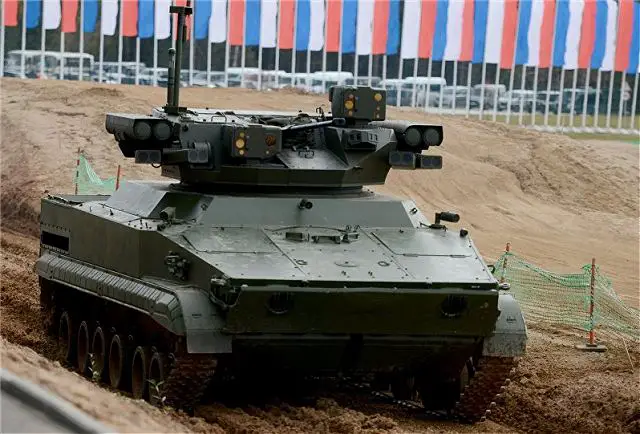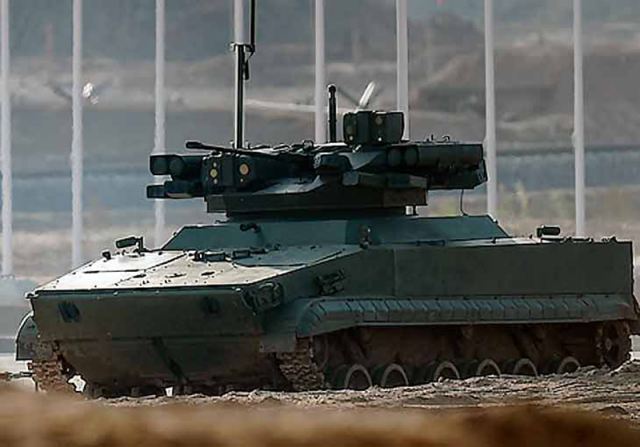Russian Udar UCGV Unmanned Combat Ground Vehicle will be a fully autonomous robotic system TASS 12707161
|
|
|||
|
Military Defense Industry Technology - Udar UCGV
|
|||
|
|
|||
| Russian Udar UCGV Unmanned Combat Ground Vehicle will be a fully autonomous robotic system. | |||
|
Russian Udar (Strike) Unmanned Combat Ground Vehicle (UCGV) developed by the Kovrov-based VNII Signal scientific-research institute will be a fully autonomous robotic system, according to a source in the Russian defense industry.
|
|||
|
|
|||
 Russian-made Udar UCGV Unmanned Combat Ground Vehicle during live test demonstration in Russia Russian-made Udar UCGV Unmanned Combat Ground Vehicle during live test demonstration in Russia |
|||
|
|
|||
| "The Udar UCGV is ready to be tested. The VNII Signal institute is working on the transformation of the vehicle into a fully autonomous robot, being able to conduct fighting and reconnaissance operations in the automatic mode. Hence, it is supposed to be a remotely controlled vehicle," the source said. He pointed out that the Udar UCGV was unveiled at the Innovation Days 2015 defense exhibition conducted by Russia`s Ministry of Defense (MoD). "The robot took part in the live demonstrations during the event. It bridged several obstacles and destroyed several targets at the firing range. Udar is named "a state-of-the-art vehicle", as it is a heavy remotely controlled UCGV that can fire various types of weapons, ranging from light machineguns to heavy anti-tank missiles. VNII Signal is planning to integrate an artificial intelligence (AI) with the robot. As a result, Udar will be able to analyze combat environment and to work in the automatic mode. Hence, Russia`s motor rifle and armour units may receive an extremely effective fire support vehicle that could eliminate all types of targets on the modern battlefield," the source pointed out. The Udar UCGV is based on the BMP-3 infantry fighting vehicle (IFV) designed by the Tractor Plants Concern. It incorporates the Epokha remote controlled weapon station (RCWS) developed by the Tula-based Instrument Design Bureau (Russian acronym: KBP, a subsidiary of the High-Precision Weapons holding). Epokha is armed with a 30mm 2A42 automatic cannon (chambered for 30x165mm round), a Kalashnikov PKTM machinegun (chambered for 7.62x54Rmm cartridge), and four ready-to-launch 9M133M-2 Kornet-M (NATO reporting name: AT-14 Spriggan) anti-tank guided missiles (ATGM). The module is a unified RCWS that can be installed on the newest armoured platforms developed by the Russian defense industry, namely Kurganets-25, Bumerang (Boomerang), and T-15 Armata IFVs. Udar will be able to gather intelligence data and to transport various cargoes in the automatic mode. The developers are planning to equip the vehicle with electronic warfare (EW) systems to jam the adversary`s hardware and pieces of instrumentation. It is noteworthy that the UCGV has retained the manual control mode. |
|||
|
|
|||
 |
|||
|
|
|||
|
The vehicle has an ammunition load of 500 30x165mm rounds, 2,000 7.62x54Rmm cartridges, and 4 ready-to-launch Kornet-M ATGMs. 9M133M-2 missiles can eliminate hostile armoured vehicles and low-flying aerial targets at 10,000 m distance. The fire control system (FCS) of Udar comprises a night vision device and a thermal imager. The vehicle will be able to transmit intelligence data to the dismounted soldiers via the Strelets command-and-control system. Hence, the infantry`s situational awareness in close quarter battles (CQB) will be unprecedented. The vehicle`s developers are planning to integrate Udar with motor rifle squads, companies and battalions to increase the combat performance of the dismounted soldiers.
The specifications of the new UCGV are strongly classified. The robot is supposed to retain the basic armour protection of BMP-3 (Level 5 (K) STANAG 4569, all-round protection against 25mm armour-piercing fin-stabilized discarding sabot (APFSDS) rounds at 500 m distance) beefed up through the medium of upgraded Arena active protection system (APS). Udar is supposed to be able to transport up to eight mounted soldiers on the battlefield. According to unofficial data, the UCGV will be an amphibious one. Russia`s MoD has been paying the uttermost attention to the development of robotic systems. In 2015, the Ministry unveiled the first indigenous UCGV being prepared for massive production, namely Uran-9. According to Russian defense analysts, Udar is supposed to complement Uran-9. Uran-9 has received single 2A72 cannon and two ready-to-launch 9M120 Ataka (AT-9 Spiral-2) ATGMs. |
|||
|
|
|||
|
© Copyright 2016 TASS. All rights reserved. This material may not be published, broadcast, rewritten or redistributed.
|
|||


























